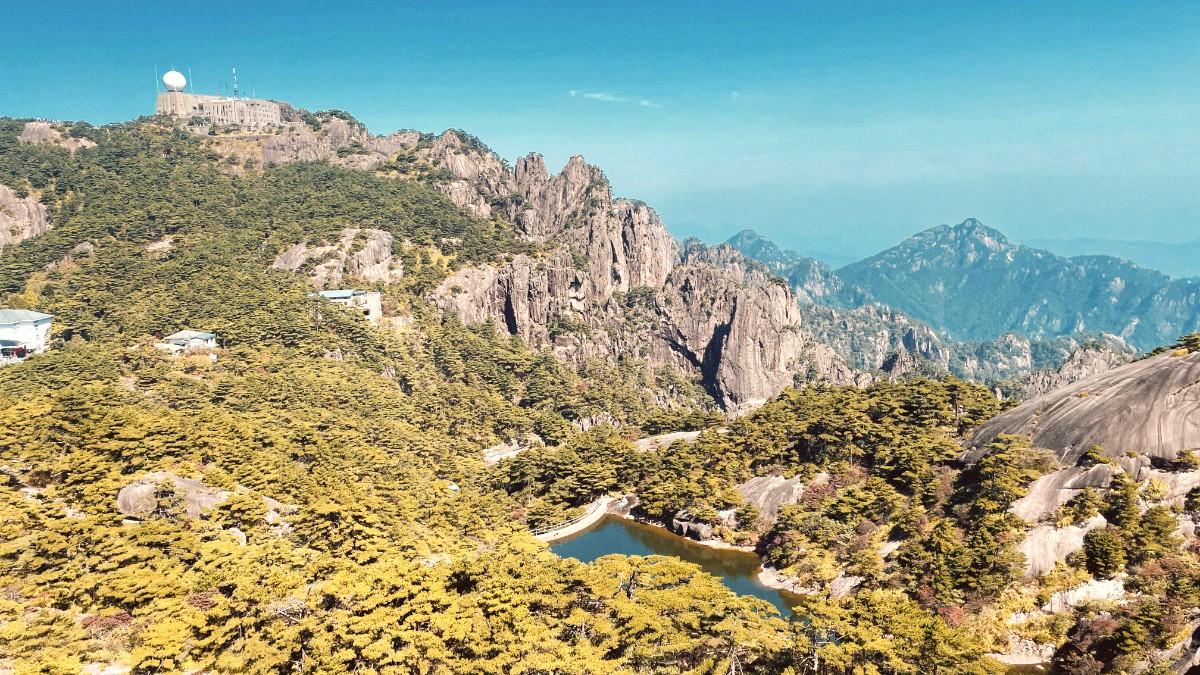
Anhui, China
Huangshan Mountain (Yellow Mountain), an UNESCO World Heritage Site, attracts visitors globally. It is famous for its "four wonders": peculiar pines, grotesque rocks, sea of clouds, and hot springs.
The scenic area typically operates from 6:30 AM to 5:00 PM during peak season (March-November) and 7:30 AM to 4:00 PM during off-peak season. Cable car hours vary. The entrance fee is ¥230 (peak) and ¥190 (off-peak). Cable car fares are separate: ¥90 one way (peak) and ¥80 one way (off-peak). Discounts for students, seniors (over 60), and children apply with valid identification. Local guides can be hired at the visitor center in Tangkou.
Small art galleries and exhibition spaces may appear on Tunxi Ancient Street, showing local art, calligraphy, and crafts.
Well-preserved ancient village with 1,800 years of history. Known for its unique Eight Trigram (Bagua) layout. Exquisite Huizhou architecture.
Both UNESCO World Heritage Sites. Famous for beautiful Huizhou-style residences, ancestral halls, intricate wood carvings. Picturesque landscapes with serene ponds. About 1-2 hours' drive from Tunxi.
Entrance fees apply, typically ¥100-¥120 each. Guided tours are often available. Purchase tickets through GetYourGuide.
Cloud Valley Temple and Ciguang Pavilion are historic Buddhist temples and cable car departure points at the mountain base. Smaller temples dot peaks and valleys.
Sites across the mountain reflect centuries of spiritual pilgrimage.
Beyond the iconic peaks, Huangshan offers hot springs, dramatic canyons, and numerous viewpoints to admire its natural splendor.
Located at the mountain base. Natural hot springs known for therapeutic qualities. Relax after hiking. Access via shuttle bus from Tangkou visitor center. Open 9:00 AM - 9:00 PM. Separate fee of approximately ¥298.
Dramatic and strenuous hiking loop on Huangshan Mountain. Features stunning rock formations, narrow paths carved into cliffsides, deep ravines.
Enter from Cloud-dispelling Pavilion. A cable car (West Sea Grand Canyon Cable Car) available for part of the descent or ascent.
At 1,864m, the highest peak of Huangshan, usually open for hiking. Ascent involves steep and narrow paths.
The second-highest peak, popular for sunrise and sunset views. A meteorological station sits at its top.
Often rotated with Lotus Peak for preservation. Features steep ascent via narrow, challenging steps, including "Carp's Backbone."
Famous for the "Monkey Gazing at the Sea" rock formation and excellent sunrise views.
A popular scenic viewpoint offering unique perspectives of the peaks.
Another viewpoint, a starting point for the West Sea Grand Canyon. Also known as Feilai Shi.
Beyond the popular sites, Huangshan offers lesser-known spots for unique experiences and fewer crowds.
Huangshan's historical roots run deep, with ancient towns showing the distinctive Huizhou culture.
A historic county town near Huangshan City. It served as the original administrative center of the Huizhou prefecture.
The Huizhou region is famous for its "Four Treasures of the Study" - brush, ink, paper, and inkstone.
Huangshan and its surroundings host several significant religious and spiritual sites, reflecting centuries of devotion.
Beyond formal sites, observing daily life in Tunxi Ancient Street and surrounding villages provides cultural insights.
Huangshan offers natural beauty and cultural heritage.
Visit a local tea garden to learn about Huangshan Maofeng tea production and participate in a traditional tea tasting ceremony.
Explore the exquisite craftsmanship of traditional Huizhou architecture in the ancient villages and on Tunxi Ancient Street.
Discover local artisan workshops showing inkstones, wood carvings, and traditional Chinese painting.
Spring (April-May) and Autumn (September-October) have pleasant weather and scenery. Winter offers unique snowscapes and fewer crowds.
Book tickets for attractions hereThe trails are well-marked. Wear sturdy hiking shoes and dress in layers. Bring water and snacks. Consider walking poles for steep sections.
Public buses connect Tunxi, Tangkou, and the ancient villages. Taxis and private drivers are also available for convenience.
Huangshan offers incredible photographic subjects. Consider a wide-angle lens for landscapes and a telephoto for distant peaks and pines.
Stay on marked paths. Do not litter. Respect wildlife. In case of emergency, contact park staff or emergency services.
The museums in Tunxi cultural context for understanding the Huizhou region before or after your mountain adventure.
Hongcun and Xidi villages World Heritage Sites worth exploring for their traditional architecture and serene beauty.
For a smooth experience, purchase your Huangshan Mountain and cable car tickets online in advance, especially during peak travel times. This saves time at the entrance.
Check the weather forecast for the mountain before you ascend, as conditions can differ significantly from the city and change rapidly.
Huangshan offers unique experiences throughout the year. Discover seasonal beauty and authentic local life.
Tachuan Village is especially known for its stunning autumn foliage, a spectacle often overlooked by many visitors.
Emerald Valley (Bixitan) a serene scenic area featuring emerald-green pools and waterfalls, offering a tranquil nature experience.
Experience Huangshan's different seasonal moods. Each season reveals a distinct charm.
Winter offers snow-covered landscapes and ice formations.
Beyond famous sites, local villages authentic insights into Huizhou culture and daily routines.
A quieter experience away from main tourist throngs.
Explore traditional crafts and cultural activities in small workshops within Tunxi Ancient Street or nearby villages.
These experiences insights into local artistry.
Dedicate sufficient time for Huangshan Mountain, considering cable car options and hiking difficulty.
Visit Hongcun, Xidi, and Chengkan for cultural and architectural beauty. Plan for full-day excursions.
Seek out less-traveled spots like Tachuan Village or Emerald Valley for quieter, unique experiences.